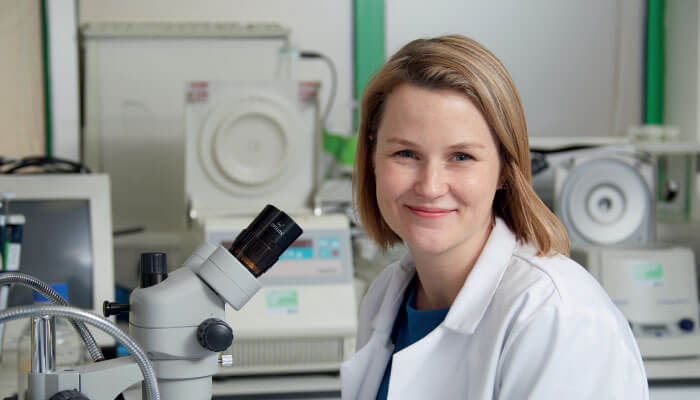
How and why did you get into the genetics of Fuchs’ dystrophy?
Fuchs’ endothelial corneal dystrophy (FECD) is the most common corneal dystrophy, affecting up to 4.5 percent of individuals over 50 years of age. It is an inherited, age-related, degenerative condition that primarily affects the innermost layer of the cornea and it is the most frequent indication for corneal transplantation in the developed world. Corneal transplantation is currently the only treatment option available for patients experiencing visual loss. However, these are invasive procedures that rely upon specialist facilities and healthy donor corneas, of which there is currently a global shortage. With life expectancy rapidly increasing, age-related conditions such as FECD are placing an increasing burden on healthcare systems, so we are looking for innovative (donor tissue independent) and preventative therapies to address this global healthcare need.
In 2013, I was working on a group of conditions associated with corneal endothelial disease with Alison Hardcastle and Steve Tuft, and the discovery that FECD was associated with a triplet repeat expansion within a gene called TCF4 gave me the impetus to develop my own independent research program. In 2015, I was awarded a Fight for Sight fellowship to work on the genetics of primary corneal endothelial disease, and decided to initially focus my efforts on developing endothelial cell culture methods to study the pathophysiology of TCF4 triplet expansion-mediated FECDs. I subsequently partnered with ProQR Therapeutics to explore the therapeutic potential of antisense oligonucleotides (ASO) therapy to treat this repeat expansion-induced pathology (1).
What is the current focus of your research program?
Our program aims to identify genetic causes of corneal endothelial disease, investigate how and why different disease-associated mutations cause endothelial cell dysfunction, and use this knowledge to develop new preventative therapies. To identify the genetic origins of disease, my lab analyzes patient DNA samples using a broad range of DNA sequencing methodologies. In parallel, using donated tissue removed during planned corneal transplant surgery, we use specialist techniques to grow and maintain the corneal endothelial cells, enabling us to study how and why particular mutations cause cellular dysfunction and disease. We aim to harness this knowledge to design preventative gene-directed treatment strategies and diagnostic test (1, 2).
What are the key findings of your work?
My lab has demonstrated that 80 percent of patients affected by FECD in the UK have the same genetic cause of disease; the aforementioned triplet repeat expansion within the TCF4 gene (1). We have also made significant progress with respect to understanding rarer genetic subtypes of corneal endothelial disease (3, 4, 5, 6, 7). Furthermore, we have developed an in vitro patient cell-derived model to learn about mutation-induced pathology and develop ASO therapies to treat the most common genetic cause of the disease. Our proof-of-concept data suggest that this approach could be an effective preventive therapy for this common sight-threatening disease in the future (1). Most recently, we have developed an innovative method to sequence the disease-associated TCF4 repeat expansion. The method, termed “No Amp Targeted Sequencing,” provides a robust and accurate method for genotyping clinically-relevant samples and overcomes the limitations of alternative approaches. Furthermore, work has revealed that the TCF4 mutation behaves in a dynamic way, providing novel insights into the cellular mechanism responsible for the disease (2).
What impact could your research have on patient outcomes?
When we understand the genetic causes and underlying pathogenic mechanisms that are responsible for inherited corneal endothelial dystrophies, the knowledge gained can be translated into improved clinical care including earlier detection (genetic and clinical), and improved treatment strategies and outcomes.
What are your plans and expectations for the future?
I am actively collaborating with ProQR Therapeutics to develop a preventative ASO therapeutic approach to treat the most common genetic causes of FECD. As a scientific community, our understanding of genetics and how an individual’s genome predisposes them to disease has advanced immeasurably over the past decade. However, we are only starting to realize the clinical and translational potential of this knowledge. In the next decade I anticipate – and hope – we will see many exciting advances in the field of personalized genomic medicine that will have a positive impact on people’s health.

References
- C Zarouchlioti et al., Am J Hum Genet, 102, 528 (2018). PMID: 29526280.
- NJ Hafford-Tear et al., Genet Med, [Epub ahead of print] (2019). PMID: 30733599.
- P Liskova et al., Am J Hum Genet, 102, 447 (2018). PMID: 29499165.
- AE Davidson et al., Am J Hum Genet, 98, 75 (2016). PMID: 26749309.
- P Liskova et al., Eur J Hum Genet, 24, 985 (2016). PMID: 26508574.
- AE Davidson et al., Eur J Hum Genet, [Epub ahead of print] (2019). PMID: 31201376.
- L Dudakova et al., Exp Eye Res, 182, 160 (2019). PMID: 30851240.
